Pellets Obtained from the Husks of Sunflower Seeds and Beech Sawdust for Comparison
Abstract
:1. Introduction
2. Materials and Methods
3. Results
3.1. Dimensions, Moisture Content and Density
3.2. Modeling the Density of Pellets Related to Moisture Content
3.3. The Shear Strength of Pellets
3.4. Calorific Value of Pellets
3.4.1. Modeling the Calorific Value of the Pellets from the Shells of Sunflower Seeds Relating to the Amount of Oil
3.4.2. Mathematical Modeling of Calorific Value Depending on the Moisture Content of the Pellets
3.5. Energetic Density
3.6. Energy Release Rate
3.7. Ash Content
3.8. Calorific Value Modeling Depending on the Ash and Carbon Content
3.9. Fixed Carbon, Ash Content and Volatile Matter
3.10. Torrefaction Results
4. Discussion
5. Conclusions
Author Contributions
Funding
Data Availability Statement
Acknowledgments
Conflicts of Interest
References
- Spirchez, C.; Lunguleasa, A.; Croitoru, C. Ecological briquettes from sunflower seed husk. In Proceedings of the International Conference Renewable Energy and Environment Engineering (REEE 2018), Paris, France, 29–31 October 2018; E3S Web of Conferences. Volume 80. [Google Scholar] [CrossRef]
- Breeze, P. Energy from Waste, 1st ed.; 2017 Paperback eBook; Academic Press: Cambridge, MA, USA, 2017; ISBN 9780128095133. Available online: https://www.perlego.com/book/1828014/energy-from-waste-pdf (accessed on 26 July 2023).
- Krajnic, N. Wood Fuels Handbook; Food and Agriculture Organization of the United Nations (FAO): Pristina, Croatia, 2015; Available online: http://large.stanford.edu/courses/2017/ph240/timcheck1/docs/fao-krajnc-2015.pdf (accessed on 23 June 2023).
- Venendaal, R.; Jørgensen, U.; Foster, C.A. European energy crops: A synthesis. Biomass Bioenergy 1997, 13, 147–185. [Google Scholar] [CrossRef]
- Boutin, J.P.; Gervasoni, G.; Hlep, R.; Seyboth, K.; Lamers, P.; Ratton, M.; McCormick, K.; Mundaca, L.; Plepys, A. Alternative energy sources in Transition Countries. The case of Bio-energy in Ukraine. Environ. Eng. Manag. J. (EEMJ) 2007, 6, 3–11. Available online: http://www.eemj.icpm.tuiasi.ro/pdfs/vol6/no1/2_Jean-Philippe%20Boutin.pdf (accessed on 12 April 2023).
- Okello, C.; Pindozzi, S.; Faugno, S.; Boccia, L. Bioenergy potential of agricultural and forest residues in Uganda. Biomass Bioenergy 2013, 56, 515–525. [Google Scholar] [CrossRef]
- Cui, X.; Yang, J.; Shi, X.; Lei, W.; Huang, T.; Bai, C. Palletization of Sunflower Seed Husks: Evaluating and Optimizing Energy Consumption and Physical Properties by Response Surface Methodology (RSM). Processes 2019, 7, 591. [Google Scholar] [CrossRef]
- FAO (Food and Agricultural Organisation of United Nations). 2022. Available online: https://www.fao.org/faostat/en/#search/vegetable%20pellets (accessed on 26 July 2022).
- Energy Institute. 2022. Available online: https://www.energyinst.org/statistical-review (accessed on 11 August 2023).
- Bioenergy Europe. 2023. Available online: https://epc.bioenergyeurope.org/about-pellets/pellets-statistics/world-pellet-map/ (accessed on 5 October 2023).
- Martínez, M.G.; Dupont, C.; Thiéry, S.; Meyer, X.M.; Gourdon, C. Impact of biomass diversity on torrefaction: Study of solid conversion and volatile species formation through an innovative TGA-GC/MS apparatus. Biomass Bioenergy 2018, 119, 43–53. [Google Scholar] [CrossRef]
- Park, J.; Yu, S.; Kim, H.; Jo, H.; Min, K.; Lee, J.; Heo, J.; Ryu, C. Co-combustion of refuse plastic fuel from marine plastics with wood pellets in a fixed-bed: Identification of minimum cofiring ratio and ideal air flow rate. Fuel 2023, 344, 128092. [Google Scholar] [CrossRef]
- Brožek, M.; Nováková, A.; Kolářová, M. Quality evaluation of briquettes made from wood waste. Res. Agric. Eng. 2012, 58, 30–35. [Google Scholar] [CrossRef]
- Samuelsson, R.; Larsson, S.; Thyrel, M.; Lestander, T. Moisture content and storage time influences the binding mechanisms in biofuel pellets. Appl. Energy 2012, 99, 109. [Google Scholar] [CrossRef]
- Rosa, P.M.; Antoniassi, R.; Freitas, S.C.; Bizzo, H.R.; Zanotto, D.L.; Oliveira, M.F.; Castiglioni, V.B.R. Chemical composition of Brazilian sunflower varieties. Helia 2009, 32, 145–156. [Google Scholar] [CrossRef]
- Serrano-Vega, M.J.; Garcés, R.; Martínez-Force, E. Cloning, characterization and structural model of a fat A-type thioesterase from sunflower seeds (Helianthus annuus L.). Planta 2005, 221, 868–880. [Google Scholar] [CrossRef] [PubMed]
- Zygarlicke, C.; Folkedahl, B. Effects of biomass blending on combustion ash. Prepr Pap.-Am. Chem. Soc. Div. Fuel Chem. 2003, 48, 641. [Google Scholar]
- EN 14588; Solid Biofuels—Terminology, Definition and Description. European Committee for Standardization: Brussels, Belgium, 2010.
- ENplus® ST 1001; ENplus® 2023, Wood Pellets—Requirements for Companies. European Committee for Standardization: Brussels, Belgium, 2023.
- ENplus® ST 1002; Requirements for Certification and Testing Bodies Operating ENplus® Certification. European Committee for Standardization: Brussels, Belgium, 2023.
- ENplus® ST 1003; Usage of the ENplus® Trademarks—Requirements. European Committee for Standardization: Brussels, Belgium, 2023.
- ISO 17225-1; Solid Biofuels—Fuel Specifications and Classes—Part 1: General Requirements. International Organization for Standardization (ISO): Geneva, Switzerland, 2021.
- EN 16127; Solid Biofuels—Determination of Length and Diameter of Pellets. International Organization for Standardization (ISO): Geneva, Switzerland, 2015.
- EN 14774-1:2009; Solid Biofuels—Determination of Moisture Content—Oven Dry Method—Part 1: Total Moisture—Reference Method. European Committee for Standardization: Brussels, Belgium, 2009.
- EN 14774-2:2009; Solid Biofuels—Determination of Moisture Content-Oven Dry Method-Part 2: Total Moisture—Simplified Procedure. European Committee for Standardization: Brussels, Belgium, 2009.
- EN 14775; Solid Biofuels—Determination of Ash Content. European Committee for Standardization: Brussels, Belgium, 2009.
- ASTM E-1755-01 2003; Standard Method for the Determination of Ash in Biomass. ASTM International, 100 Barr Harbor Drive: West Conshohocken, PA, USA, 2003.
- EN 14918; Solid Biofuels—Determination of Calorific Value. European Committee for Standardization: Brussels, Belgium, 2009.
- DIN 51900-1 2000; Determining the Gross Calorific Value of Solid and Liquid Fuels Using the Bomb Calorimeter, and Calculation of Net Calorific Value—Part 1: General Information. German Institute for Standardization: Berlin, Germany, 2000.
- EN 15148 [2009]; Solid Biofuels—Determination of the Content of Volatile Matter. European Committee for Standardization: Brussels, Belgium, 2009.
- EN 15103; Solid Biofuels—Determination of Bulk Density. European Committee for Standardization: Brussels, Belgium, 2009.
- ÖNORM M7135 [2000]; Pellets and Briquettes-Requirements and Test Conditions. Austria Standards Institute: Vienna, Austria, 2000.
- CTI-R 04/5 [2004]; Solid Bio-Combustibles—Characterization of the Pellet to Fine Energy. Italian Organization for Standardization: Milano, Italy, 2004.
- DIN 51731:1996; Testing of Solid Fuels—Compressed and Untreated Wood—Requirements and Testing. German Institute for Standardization: Berlin, Germany, 1996.
- Verna, V.K.; Bram, S.; De Rucky, J. Small scale biomass systemsː Standards, Quality, Labeling and Market Driving Factors—An Outlook. Biomass Bioenergy 2009, 33, 1393–1402. [Google Scholar] [CrossRef]
- Hahn, B. Existing Guidelines and Quality Assurance for Fuel Pellets—Pellets for Europe Project; UMBERA Publishing: Saint Pölten, Austria, 2004. [Google Scholar]
- EN 1995-1-1:2004+A1; Eurocode 5: Design of Timber Structures—Part 1-1: General—Common Rules and Rules for Buildings. European Committee for Standardization: Brussels, Belgium, 2008.
- Abuelnuor, A.A.A.; Wahid, M.A.; Hosseini, S.E.; Saat, A.; Saqr, K.M.; Sait, H.H.; Osman, M. Characteristics of biomass in flameless combustion: A review. Renew. Sustain. Energy Rev. 2014, 33, 363–370. [Google Scholar] [CrossRef]
- Popescu, B.; Șenilă, L.; Vărăticeanu, C.; Șimon, G. Cellulosic bioethanol from sunflower seed hulls -a renewable energy source. Stud. Univ. Babes-Bolyai Ambient. 2013, 58, 105–110. [Google Scholar]
- ISO 17828:2015; Solid Biofuels, Determination of Bulk Density. International Organization for Standardization (ISO): Geneva, Switzerland, 2015.
- ASABE Standards, S269.4; Cubes, Pellets, and Crumbles—Definitions and Methods for Determining Density, Durability, and Moisture Content. ASABE: St. Joseph, MO, USA, 2007.
- Kaliyan, N.; Morey, R.V. Factors affecting strength and durability of densified biomass product. Biomass Bioenergy 2009, 33, 337–359. [Google Scholar] [CrossRef]
- Czachor, G.; Bohdziewicz, J.; Kawa, K. Shear strength of the selected types of pellets. Agric. Eng. 2016, 20, 35–42. [Google Scholar] [CrossRef]
- Pintiaux, T.; Viet, D.; Vandenbossche, V.; Rigal, L.; Rouilly, A. Binderless materials obtained by thermo-compressive processing of lignocellulosic fibers: A comprehensive review. BioResources 2015, 10, 1915–1963. [Google Scholar] [CrossRef]
- SS 18 71 20 [1998]; Biofuels and Peat—Fuel Pellet—Classification. Swedish Standards Institute: Stockholm, Sweden, 1998.
- ASTM E1755-01; Standard Method for the Determination of Ash in Biomass. American Society for Testing and Materials, International: Philadelphia, PA, USA, 2007.
- Ross, R. Wood Handbook—Wood as an Engineering Material; General Technical Report 113; Department of Agriculture, Forest Service, Forest Products Laboratory: Madison, WI, USA, 2020.
- Nosek, R.; Holubcik, M.; Jandacka, J. The impact of bark content of wood biomass on biofuel properties. BioResources 2016, 11, 44–53. [Google Scholar] [CrossRef]
- Demirbaş, A. Relationships between lignin contents and fixed carbon contents of biomass samples. Energy Convers. Manag. 2003, 44, 1481–1486. [Google Scholar] [CrossRef]
- Demirbaş, A. Relationships between Heating Value and Lignin, Fixed Carbon, and Volatile Material Contents of Shells from Biomass Products. Energy Sources 2003, 25, 629–635. [Google Scholar] [CrossRef]
- Bridgwater, A.V. Review of Fast Pyrolysis of Biomass and Product Upgrading. Biomass Bioenergy 2012, 38, 68–94. [Google Scholar] [CrossRef]
- Demirbaş, A. Resource facilities and biomass conversion processing for fuels and chemicals. Energy Convers. Manag. 2003, 42, 1357–1378. [Google Scholar] [CrossRef]
- Liu, X.; Hua, W.; Wu, S. Characterization of thermo-chemical degradation and pyrolysis properties for three kinds of biomass residues. BioResources 2016, 11, 8806–8819. [Google Scholar] [CrossRef]
- Zhou, Q.; Le, Q.V.; Yang, H.; Gu, H.; Yang, Y.; Sonne, C.; Tabatabaei, M.; Lam, S.S.; Li, C.; Chen, X.; et al. Sustainable conversion of agricultural biomass into renewable energy products: A Discussion. BioResources 2022, 17, 3489–3508. [Google Scholar] [CrossRef]
- Martinka, J.; Rantuch, P.; Balog, K. Fire hazard and heat of combustion of sunflower seed hull pellets. J. Therm. Anal. Calorim. 2017, 130, 1531–1540. [Google Scholar] [CrossRef]
- Jeong, S.; Lee, C.G.; Kim, D.H. Characteristic Analysis of Torrefied Pellets: Determining Optimal Torrefaction Conditions for Agri-By-product. Energies 2020, 13, 423. [Google Scholar] [CrossRef]
- Islamova, S.I.; Ermolaev, D.V.; Bulygina, K.S. Oxidative Torrefaction of Sunflower Husk Pellets in the Kaolin Layer. Bioenergy Res. 2022, 15, 183–192. [Google Scholar] [CrossRef]
- Būmane, S.; Poiša, L.; Čubars, E.; Platače, R. The analysis of carbon content in different energy crops, NJF 25-th Congress Nordic view to sustainable rural development. Crop Sci. Prod. 2015, 25, 156–160. [Google Scholar]
- Lamlom, H.; Savidge, R.A. A reassessment of carbon content in wood: Variation within and between 41 North American species. Biomass Bioenergy 2003, 25, 381–388. [Google Scholar] [CrossRef]
- Garcia, A.M.; Barcia, B.M.J.; Diaz, D.M.A.; Hernandez, J.A. Preparation of Active Carbon from a Commercial Holm-oak Charcoal: Study of Micro-and Meso-porosity. Wood Sci. Technol. 2004, 37, 385–394. [Google Scholar] [CrossRef]
- Kuhlman, T.; Diego, V.; Koomen, E. Exploring the potential of reed as a bioenergy crop in the Netherlands. Biomass Bioenergy 2013, 55, 41–52. [Google Scholar] [CrossRef]
- Whittaker, I.; Shield, C. 10—Short rotation woody energy crop supply chains. In Biomass Supply Chains for Bioenergy and Biorefining; Elsevier: Amsterdam, The Netherlands, 2016; pp. 217–248. [Google Scholar] [CrossRef]
- Kienzl, N.; Margaritis, N.; Isemin, R.; Zaychenko, V.; Strasser, C.; Kourkoumpas, D.S.; Grammelis, P.; Klimov, D.; Larina, O.; Sytchev, G.; et al. Applicability of Torrefied Sunflower Husk Pellets in Small and Medium Scale Furnaces. Waste Biomass Valor. 2021, 12, 2579–2596. [Google Scholar] [CrossRef]
- Qian, X.; Xue, J.; Yang, Y.; Lee, S.W. Thermal Properties and Combustion-Related Problems Prediction of Agricultural Crop Residues. Energies 2021, 14, 4619. [Google Scholar] [CrossRef]
- Qian, X.; Lee, S.; Soto, A.-M.; Chen, G. Regression Model to Predict the Higher Heating Value of Poultry Waste from Proximate Analysis. Resources 2018, 7, 39. [Google Scholar] [CrossRef]
- Osman, A.I.; Chen, L.; Yang, M.; Msigwa, G.; Farghali, M.; Fawzy, S.; Rooney, D.W.; Pow-Seng, Y. Cost, environmental impact, and resilience of renewable energy under a changing climate: A review. Environ. Chem. Lett. 2023, 21, 741–764. [Google Scholar] [CrossRef]
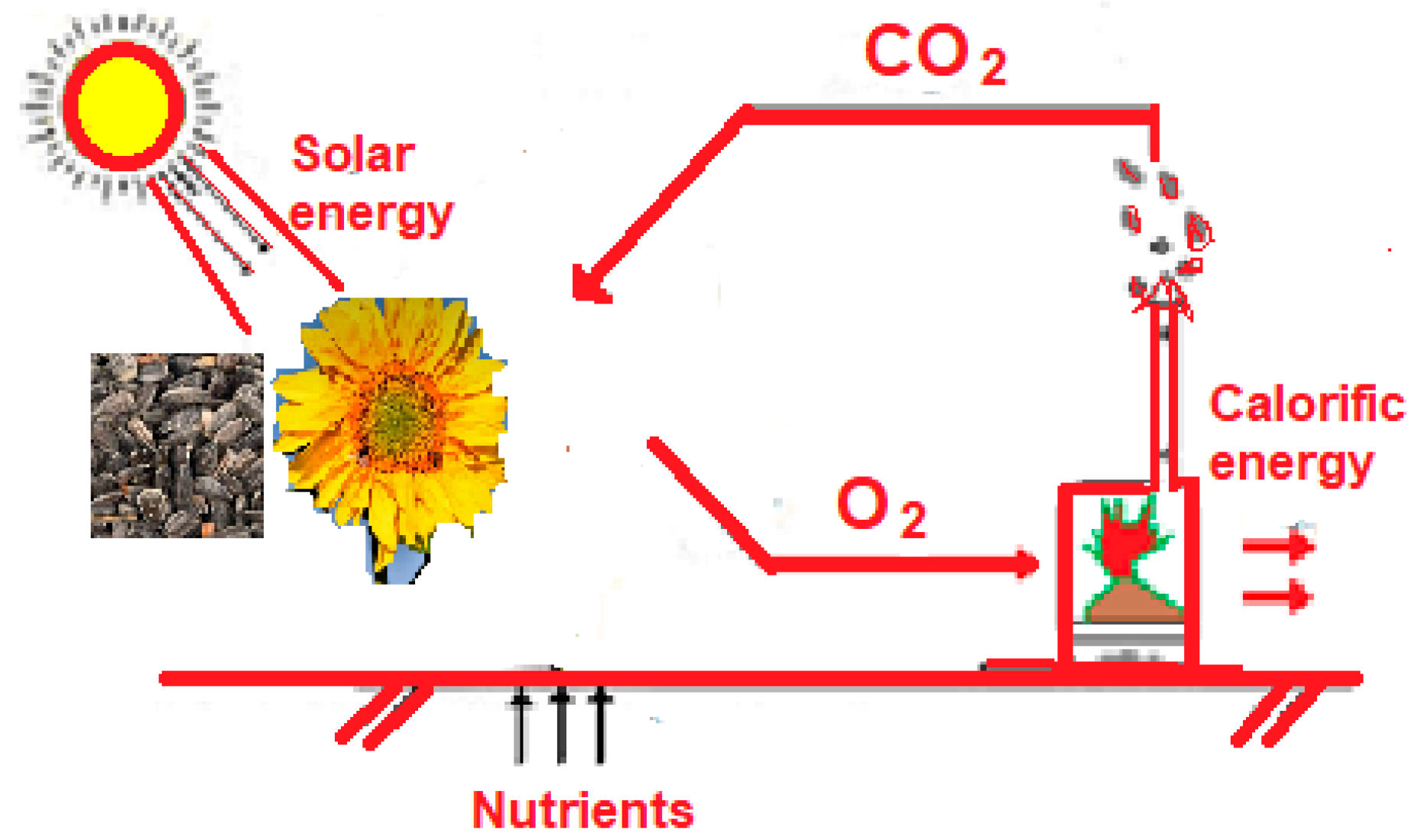
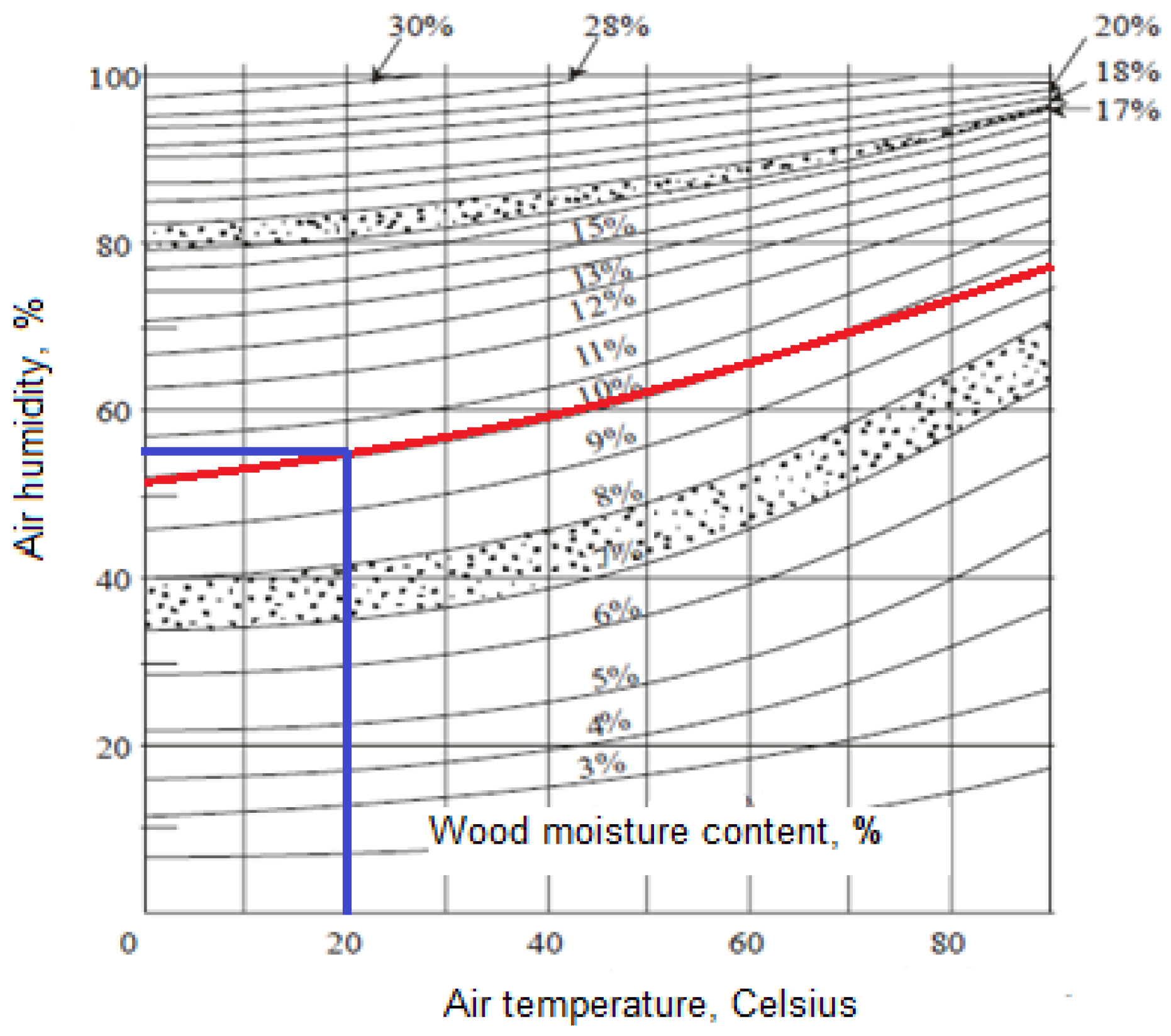
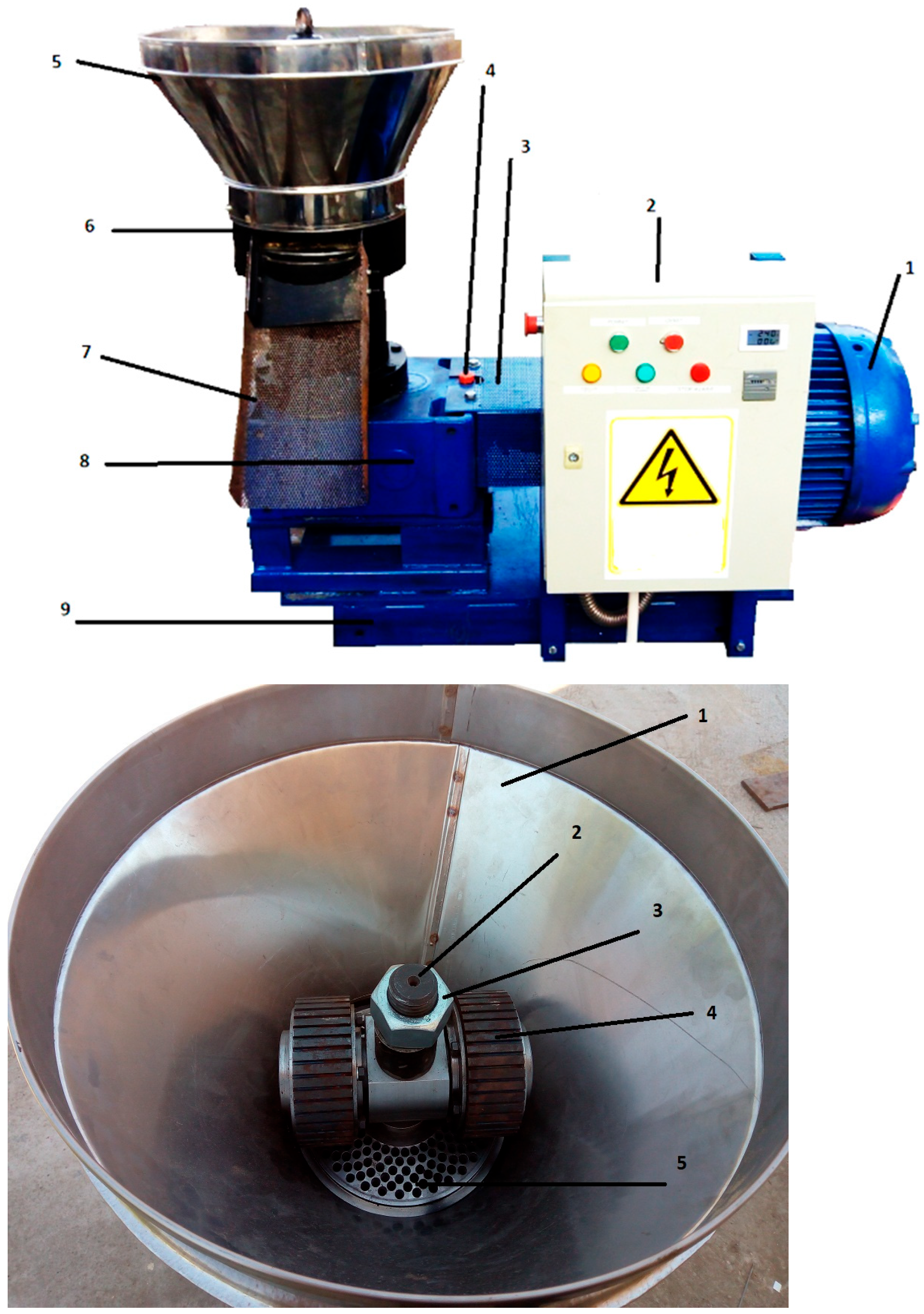



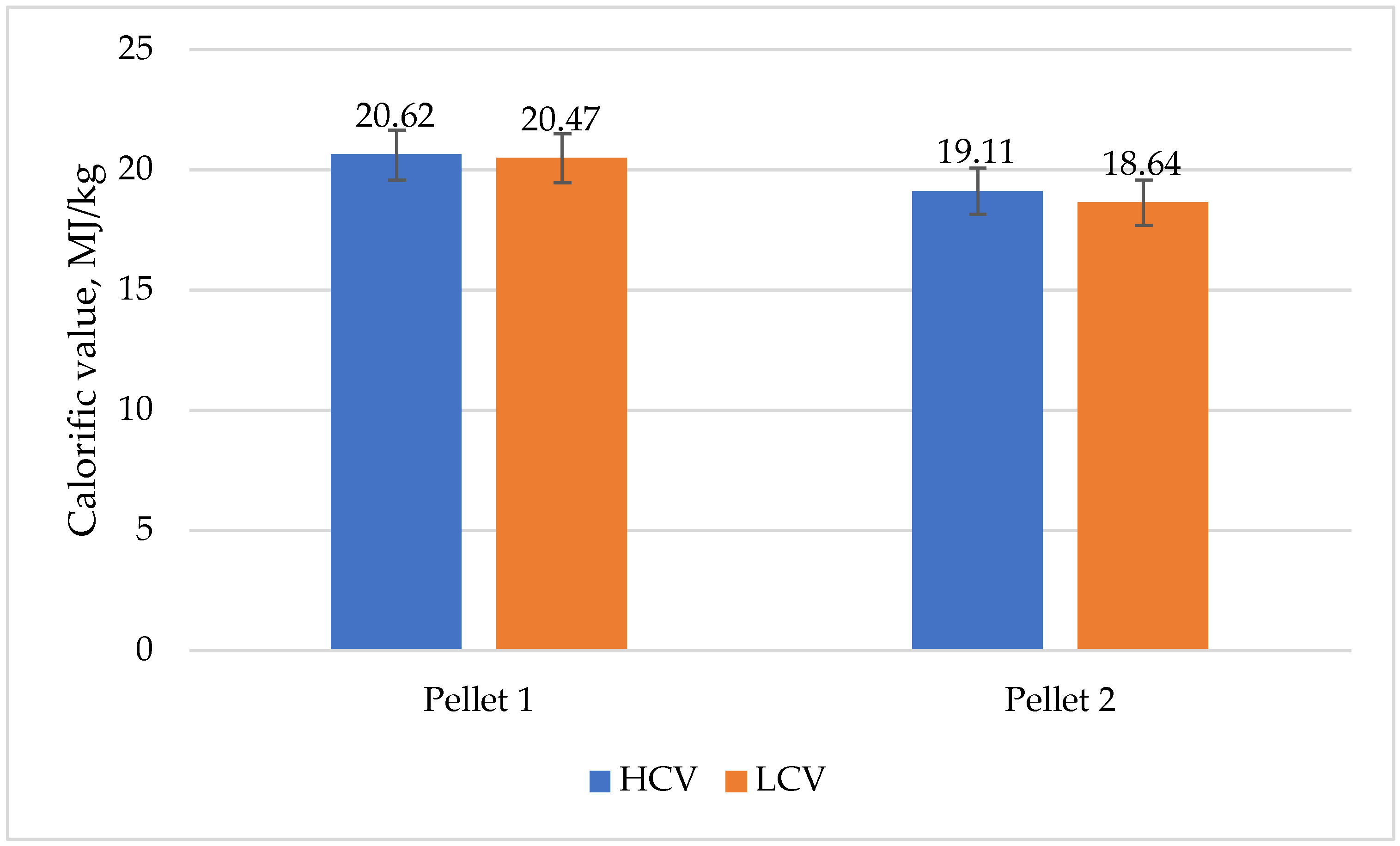


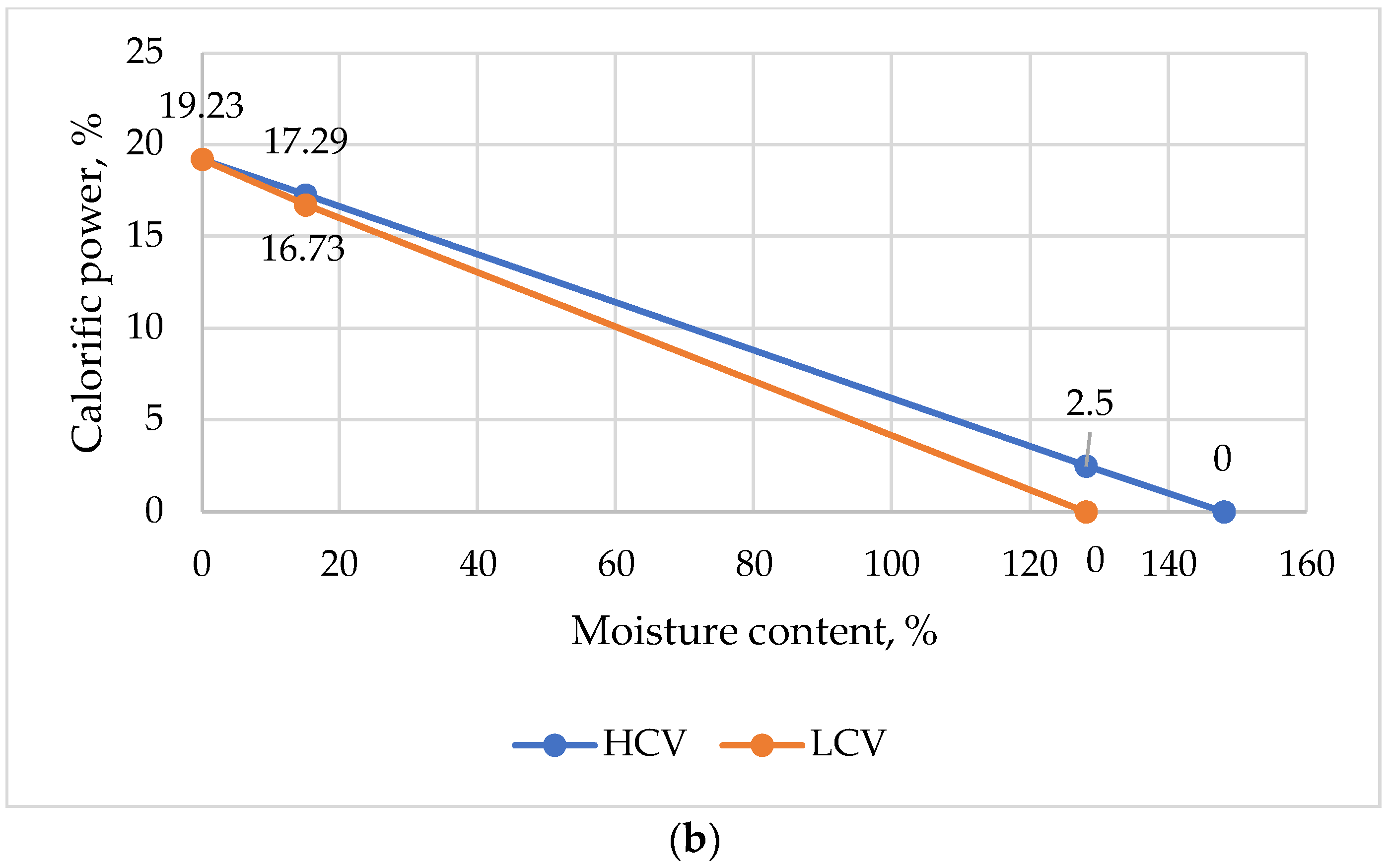
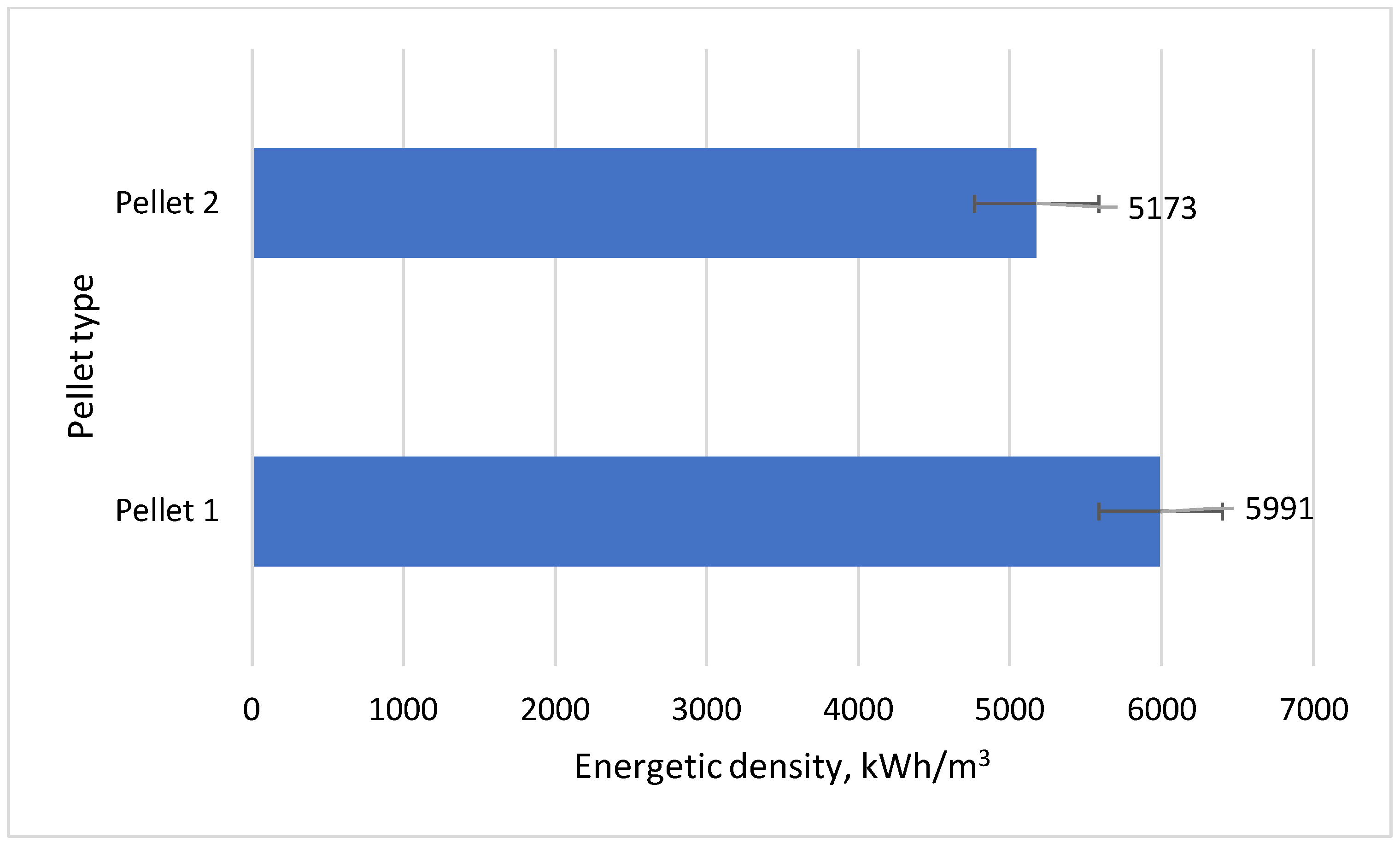

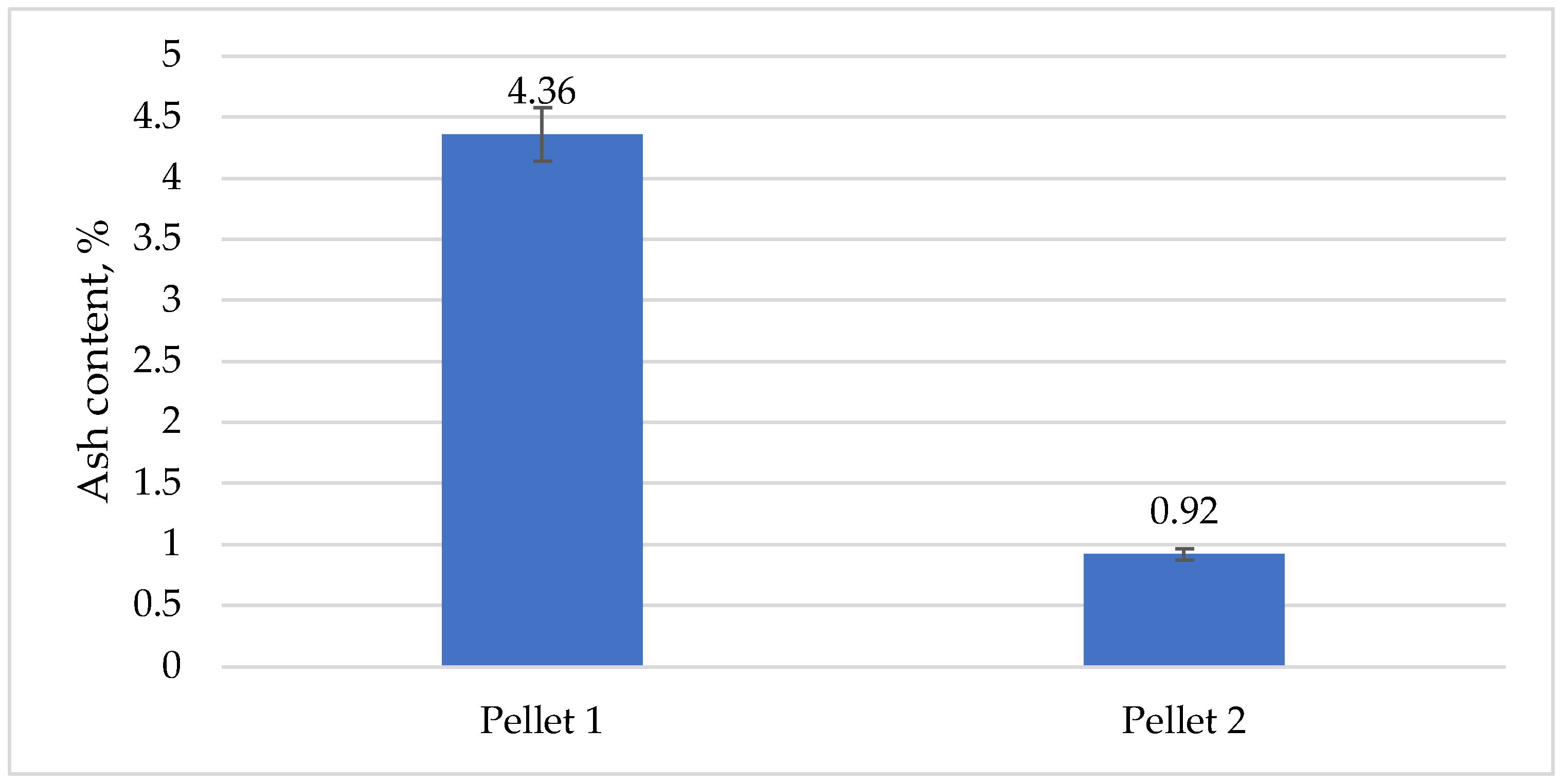
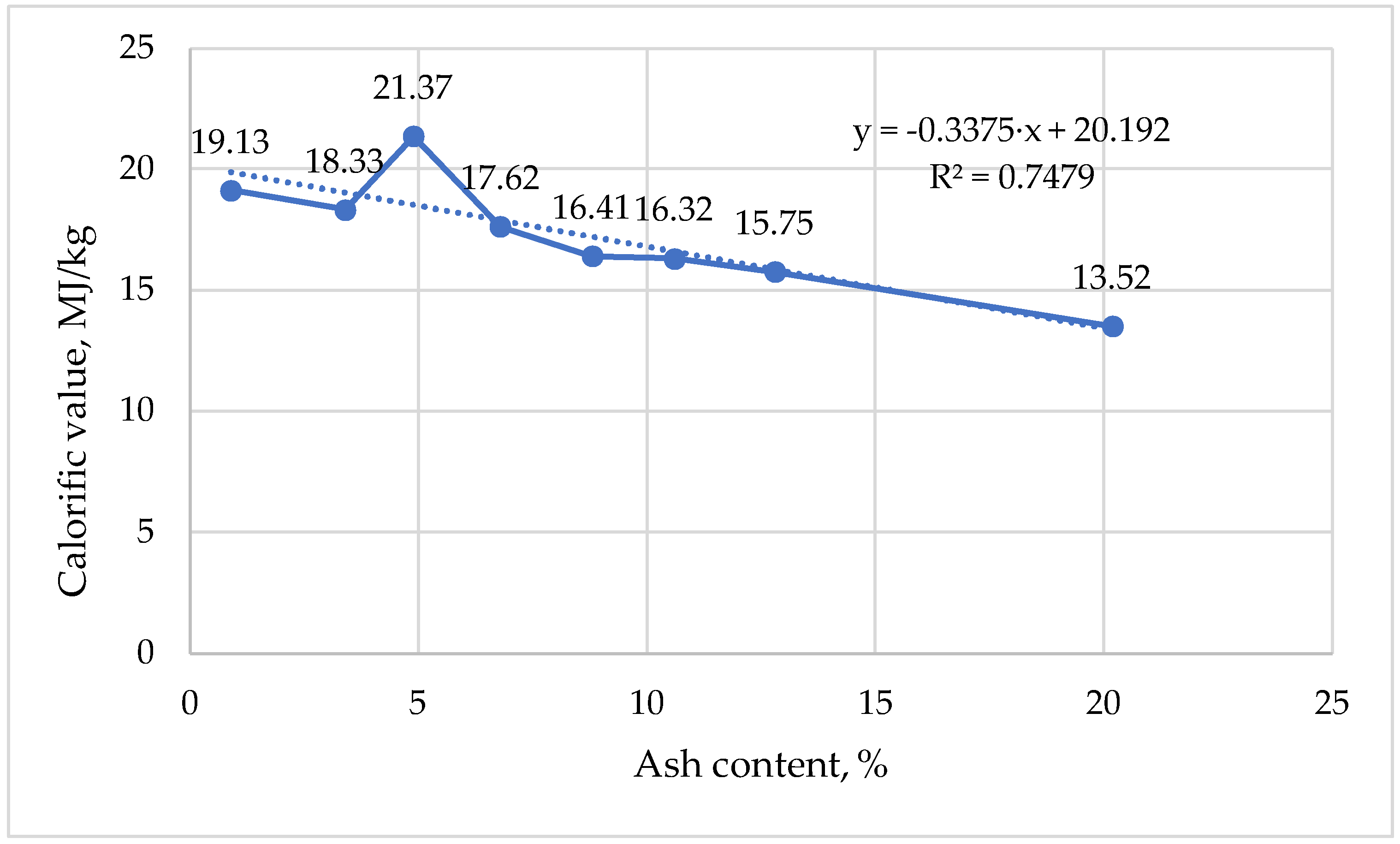

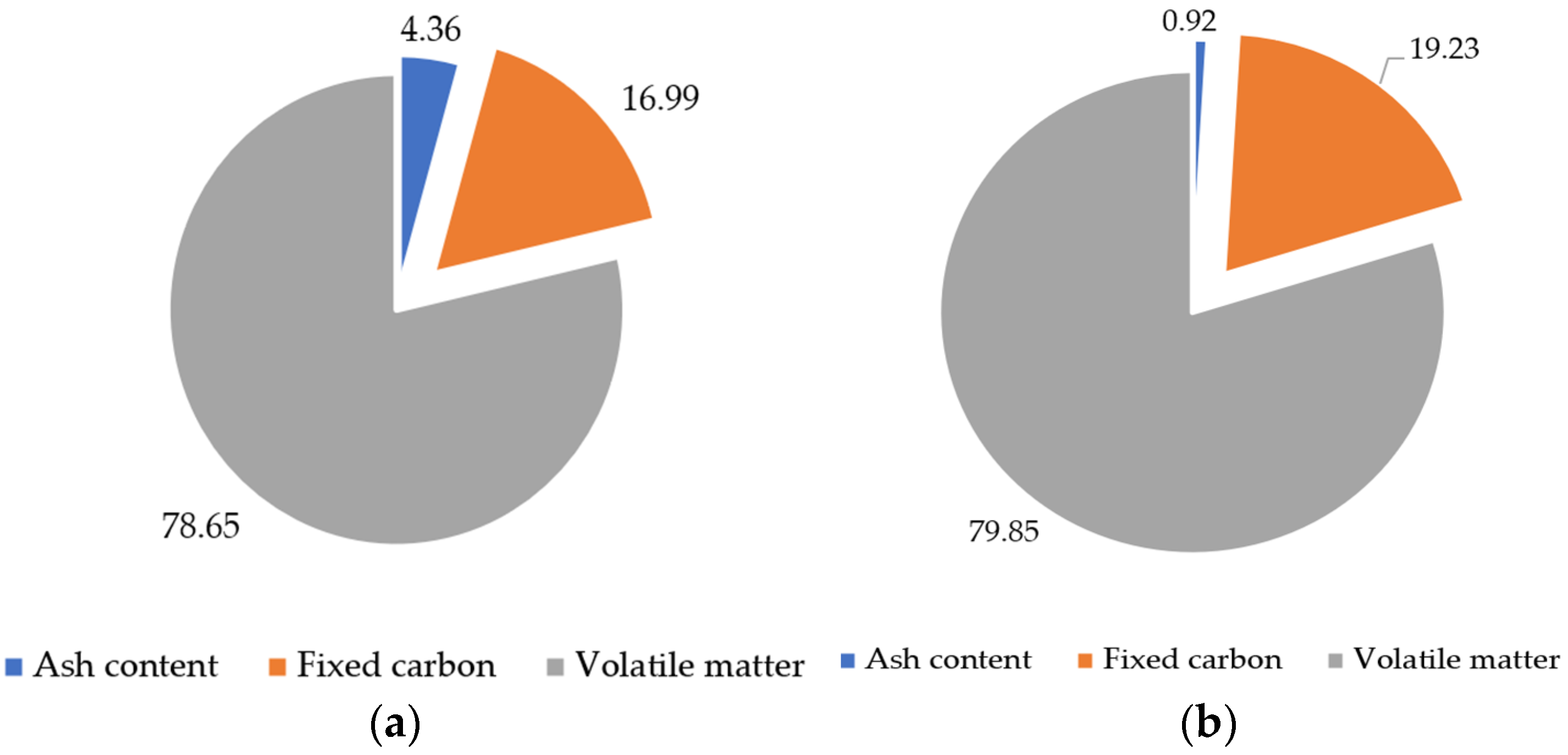
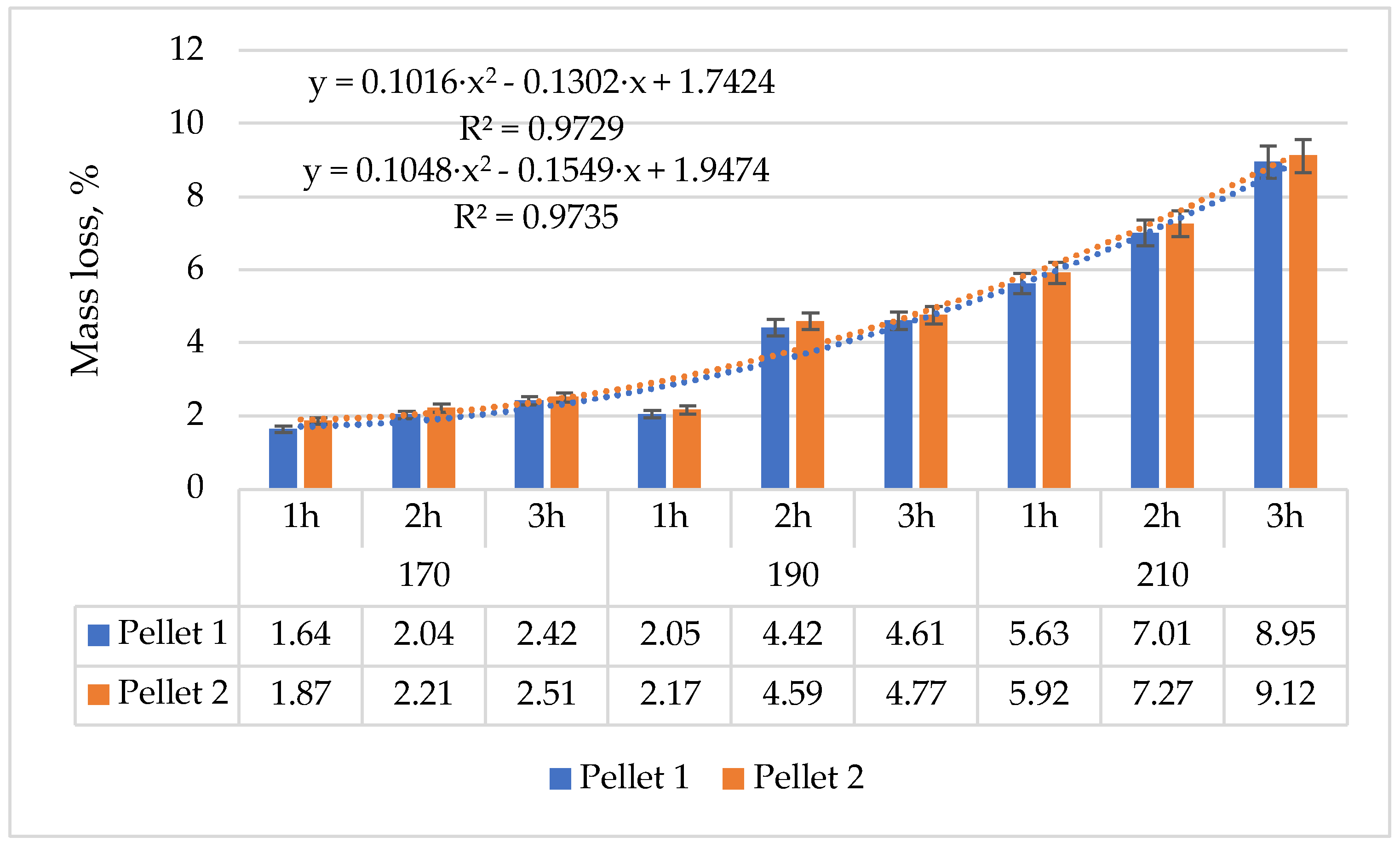
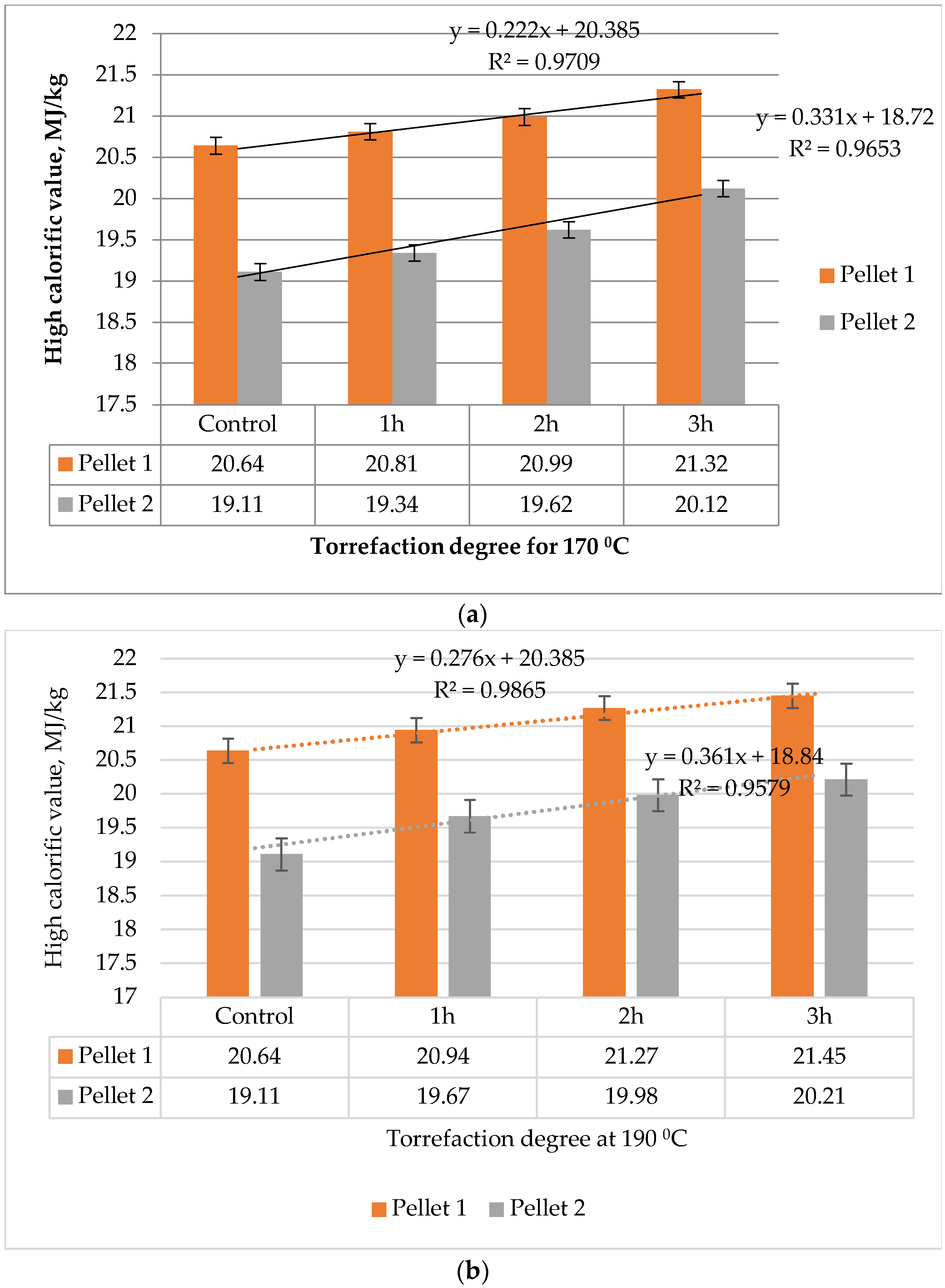


| Name of Dry Fuel Material | Calorific Values | |
|---|---|---|
| MJ/kg | Kcal/kg | |
| Firewood of beech and hornbeam species | 18.4 | 4397 |
| Wooden pellets and briquettes | 18.9 | 4517 |
| Superior coal, type Anthracite | 29.4 | 7026 |
| Inferior coal, peat-type | 23.5 | 3500 |
| Charcoal | 22.2 | 5311 |
| Petroleum | 46.2 | 11,042 |
| Methane gas | 35.1 | 8405 |
| Vegetable straw | 16.0 | 3824 |
| Characteristics | Medium Values | |
|---|---|---|
| Pellet 1 * | Pellet 2 ** | |
| Diameter, mm | 6.09 | 6.11 |
| Length, mm | 11.2 | 14.97 |
| Moisture content, % | 8.1 | 8.3 |
| Unit density, kg/m3 | 1084 | 1028 |
| Bulk density, kg/m3 | 296 | 285 |
| Coefficient of densification compared to the fine material | 7.94 | 7.88 |
| The densification coefficient compared to the raw material | ---- | 1.59 |
| Type | Pellet Density for Some Values of Moisture Content, kg/m3 | ||||||
|---|---|---|---|---|---|---|---|
| Mc = 0% | Mc = 3% | Mc = 6% | Mc = 9% | Mc = 12% | Mc = 15% | Mc = 18% | |
| Pellet 1 * | 927 | 982 | 1040 | 1120 | 1168 | 1238 | 1312 |
| Pellet 2 ** | 879 | 929 | 983 | 1040 | 1101 | 1164 | 1232 |
| Axis Ox | 0 | 15 | 89.3 | 122 | |
| Pellet 1 (Axis Oy, Figure 9) | HCV | 20.78 | 18.29 | 5.5 | 0 |
| LCV | 20.78 | 16.73 | 0 | 0 | |
| Axis Ox | 0 | 15 | 128 | 148 | |
| Pellet 2 (Axis Oy, Figure 9) | HCV | 19.23 | 17.29 | 2.5 | 0 |
| LCV | 19.23 | 16.73 | 0 | 0 | |
| Type of Pellets | Carbon, % | Hydrogen, % | Oxygen, % | Ash, % | Calorific Value, MJ/kg |
|---|---|---|---|---|---|
| Beech | 49.0 | 6,0 | 44.1 | 0.9 | 19.13 |
| Tropical species | 46.9 | 6.0 | 43.7 | 3.4 | 18.33 |
| Sunflower seeds | 55.2 | 6.0 | 33.9 | 4.9 | 21.37 |
| Corn | 44.8 | 5.9 | 42.5 | 6.8 | 17.62 |
| Grass waste | 41.6 | 5.9 | 42.1 | 8.8 | 16.41 |
| Garden waste | 41.6 | 5.9 | 41.9 | 10.6 | 16.32 |
| Acacia bark | 39.7 | 5.8 | 41.7 | 12.8 | 15.75 |
| Bean and pea pods | 33.8 | 5.8 | 40.2 | 20.2 | 13.52 |
| No. | Features | Pellet 1 | Pellet 2 | Others (References) |
|---|---|---|---|---|
| 1. | Moisture content, % | 8.1 | 8.3 | 7%–11%, [14], 9%–11%, [14] |
| 2. | Unit density, kg/m3 | 1084 | 1028 | 1000, [32] |
| 3. | Bulk density, kg/m3 | 298 | 285 | 612, [35] |
| 4. | Shear strength, N/mm2 | 2.23 | 2.45 | 5–6, pellet density 1100 kg/m3 [43] |
| 5. | Calorific value, MJ/kg | 20.64 | 19.11 | 20.2, [50] |
| 6. | Calorific value—torrefaction, MJ/kg | 21.91 | 20.28 | 20.1, [11] |
| 7. | Energetic density, KWh/m3 | 5991 | 5173 | 5000–7000, coal and wood, [49] |
| 8. | Ash content, % | 0.9 | 4.3 | Max 6 [35] |
| 9. | Fixed carbon, % | 16.9 | 19.2 | 7–15, [49] |
| 10. | Volatile matter, % | 78.6 | 79.8 | 47–69, [50] |
| 11. | Total mass loss, % | 8.95 | 9.12 | 15–20, for 2 min in nitrogen [38] |
Disclaimer/Publisher’s Note: The statements, opinions and data contained in all publications are solely those of the individual author(s) and contributor(s) and not of MDPI and/or the editor(s). MDPI and/or the editor(s) disclaim responsibility for any injury to people or property resulting from any ideas, methods, instructions or products referred to in the content. |
© 2024 by the authors. Licensee MDPI, Basel, Switzerland. This article is an open access article distributed under the terms and conditions of the Creative Commons Attribution (CC BY) license (https://creativecommons.org/licenses/by/4.0/).
Share and Cite
Lunguleasa, A.; Olarescu, A.; Spirchez, C. Pellets Obtained from the Husks of Sunflower Seeds and Beech Sawdust for Comparison. Forests 2024, 15, 902. https://doi.org/10.3390/f15060902
Lunguleasa A, Olarescu A, Spirchez C. Pellets Obtained from the Husks of Sunflower Seeds and Beech Sawdust for Comparison. Forests. 2024; 15(6):902. https://doi.org/10.3390/f15060902
Chicago/Turabian StyleLunguleasa, Aurel, Alin Olarescu, and Cosmin Spirchez. 2024. "Pellets Obtained from the Husks of Sunflower Seeds and Beech Sawdust for Comparison" Forests 15, no. 6: 902. https://doi.org/10.3390/f15060902
APA StyleLunguleasa, A., Olarescu, A., & Spirchez, C. (2024). Pellets Obtained from the Husks of Sunflower Seeds and Beech Sawdust for Comparison. Forests, 15(6), 902. https://doi.org/10.3390/f15060902





